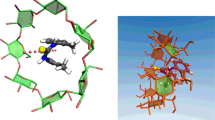Abstract
Semiempirical AM1 calculations have been performed on the inclusion complexes of α- and β-cyclodextrin with benzoic acid and phenol and β-cyclodextrin with methylated benzoic acids in the “head first” and “tail first” positions. The results show that α-cyclodextrin complexes with phenol and benzoic acid guests in the “head first” position are more stable than in the “tail first” position, while β-cyclodextrin complexes with the same guests prefer the “tail first” position. The preferred orientation for β-cyclodextrin with methylated benzoic acids is determined by the position of the methyl substituent(s). In general, para-methyl benzoic acid derivatives prefer the “tail first” position. γ-cyclodextrin forms a slightly unstable 1:1 complex with C60 (3.4 kcal/mol), but two γ-cyclodextrins provide enough stabilization by about 10 kcal/mol to “cage-in” the C60.
Similar content being viewed by others
References
Dewar, M. J. S., Zoebisch, E. G., Healy, E. F., Stewart, J. J. P., AM1: A New General Purpose Quantum Mechanical Molecular Model1,J. Am. Chem. Soc.,107, 3902–3909 (1985)
Bodor, N. S., Huang, M.-J., Watts, J. D., Theoretical Studies on the Structures of Natural and Alkylated CyclodextrinsJ. Pharm. Sci.,84, 330–336 (1995)
Bodor, N. S., Huang, M.-J., An Extended Version of a Novel Method for the Estimation of Partition Coefficients,J. Pharm. Sci.,81, 272–281 (1992)
Jeffrey, G. A., Saenger, W., Hydrogen Bonding in Biological Structures, Springer Verlag, Berlin, 1991
Steiner, Th., Saenger, W., Geometric Analysis of Non-Ionic O-H...O Hydrogen Bonds and Non-Bonding Arrangements in Neutron Diffraction Studies of Carbohydrates,Acta Crystallogr., Sect. B,48, 819-827 (1992)
Steiner, Th., Saenger, W., Role of C-H...O Hydrogen Bonds in the Coordination of Water Molecules. Analysis of Neutron Diffraction Data,J. Am. Chem. Soc.,115, 4540–4547 (1993)
Steiner, Th., Saenger, W., Reliability of assigning O-H...O hydrogen bonds to short intermolecular O...O separations in cyclodextrin and oligosaccharide crystal structures,Carbohydr. Res.,259, 1–12 (1994)
Kitagawa, M., Hoshi, H., Sakurai, M., Inoue, Y., Chujo, R., The large dipole moment of cyclomaltohexaose and its role in determining the guest orientation in inclusion complexes,Carbohydr. Res.,163, C1-C3 (1987)
Sakurai, M., Kitagawa, M., Hoshi, H., CNDO-Electrostatic Potential Maps for α-Cyclodextrin,Chem. Lett., 895–898 (1988)
Kitagawa, M., Hoshi, H., Sakurai, M., Inoue, Y., Chujo, R., A Molecular Orbital Study of Cyclodextrin Inclusion Complexes. I. The Calculation of the Dipole Moments of α-Cyclodextrin-Aromatic Guest Complexes,Bull. Chem. Soc. Jpn.,61, 4225–4229 (1988)
Sakurai, M., Kitagawa, M., Hoshi, H., Inoue, Y., Chujo, R., A Molecular Orbital Study of Cyclodextrin Inclusion Complexes. II. The Structure Analysis of α-Cyclodextrin Inclusion Complex with m-Nitrophenol in Aqueous Solution Based on the Quantum-Chemical Solvation Theory,Bull. Chem. Soc. Jpn.,62, 2067–2069 (1989)
Andersson, T., Nilsson, K., Sundahl, M., Westman, G., Wennerström, O., C60 Embedded in γ-Cyclodextrin: a Water-soluble Fullerene,J. Chem. Soc. Chem. Commun., 604–606 (1992)
Andersson, T., Westman, G., Wennerström, O., Sundahl, M., NMR and UV-VIS Investigation of Water-soluble Fullerene-60-γ-Cyclodextrin Complex,J. Chem. Soc. Perkin Trans.,2, 1097–1101 (1994)
Priyadarsini, K. I., Mohan, H., Mittal, J. P.Guldi, D. M., Asmus, K.-D., Pulse Radiolysis Studies on the Redox Reactions of Aqueous Solutions of γ-Cyclodextrin/C60 Complexes,J. Phys. Chem.,98, 9565–9569 (1994)
Boulas, P. Kutner, W., Jones, M. T., Kadish, K. M., Bucky(basket)ball: Stabilization of Electrogenerated C60 − Radical Monoanion in Water by Means of Cyclodextrin Inclusion Chemistry,J. Phys. Chem.,98, 1282–1287 (1994)
Yoshida, Z.-i., Takekuma, H., Takekuma, S.-i., Matsubara Y.,Angew. Chem. Int. Ed. Engl.,33, 1597–1599 (1994)
Priyadarsini, K. I., Mohan, H. Tyagi, A. K., Mittal, J. P., Inclusion Complex od γ-Cyclodextrin-C60: Formation, Characterization, and Photophysical Properties in Aqueous Solutions,J. Phys. Chem.,98, 4756–4759 (1994)
Kuroda, Y., Nozawa, H., Ogoshi, H., Kinetic Behaviors of Solubilization of C60 into Water by Complexation with γ-Cyclodextrin,Chemistry Letters, 47–48 (1995)
Author information
Authors and Affiliations
Rights and permissions
About this article
Cite this article
Bodor, N., Huang, MJ. & Watts, J.D. Theoretical am1 studies of inclusion complexes of α- and β-cyclodextrins with methylated benzoic acids and phenol, and γ-cyclodextrin with buckminsterfullerene. J Incl Phenom Macrocycl Chem 25, 97–102 (1996). https://doi.org/10.1007/BF01041545
Issue Date:
DOI: https://doi.org/10.1007/BF01041545




